Beware of Hopperburn!
Author: Dr. Ana Legrand, Extension Assistant Professor,
Department of Plant Science and Landscape Architecture, UConn
Ana.Legrand@uconn.edu
Reviewer: Shuresh Ghimire, Assistant Extension Educator, UConn Extension
'Hopperburn' refers to the complex of symptoms associated with potato leafhopper (PLH) feeding injury. This leafhopper, native to North America, has a
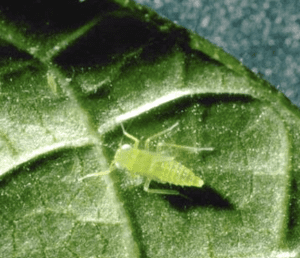
broad host plant range including 220 plant species in 26 families. Though, most of its host plants are in the legume family. Crops primarily attacked by the potato leafhopper include potato, beans, soybeans and alfalfa. Other host plants include eggplant, cucumber, Jerusalem artichokes, squash, sweet potato and rhubarb. Reports also note PLH on hops and hemp. PLH arrives every summer in June from southern locations where they overwinter in pine forests. They complete two or more generations in Connecticut before non-reproductive adults are transported back by prevailing winds to the south in the fall. Environmental conditions can have a significant impact on this insect, beginning with their inability to survive our winter temperatures. On the other hand, warmer conditions increase the severity of infestation during summer and drought can worsen its feeding damage.
Adult leafhoppers insert their eggs into plant stems and nymphs will emerge 7-14 days with warmer temperatures inducing an earlier emergence. Nymphs
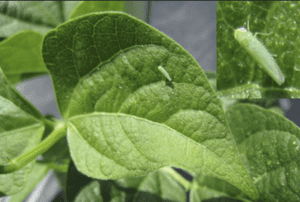
cannot fly but they do walk rather rapidly over the plant surface. Nymphs have a peculiar way of moving sideways which helps in spotting who they are. Nymphs develop through five instars eventually molting into adults that can migrate long distances aided by wind currents. Adults are small (1/8 of an inch or about 3 mm), bright green and with six white spots behind the eyes on top of the head. Adults and nymphs feed on plants using 'pierce-sucking' mouthparts, probing and damaging tissues while they inject saliva into the tissues as they feed resulting in their hallmark 'hopperburn' damage.
This type of plant damage presents general symptoms like tip-wilting in young plants, yellowing or chlorosis that expands through the leaf and plant stunting. Other specific symptoms include triangular yellowing at the leaf tips of alfalfa and some clovers. In potato, soybean and beans the leaves exhibit yellowing at the margins, leaf curling and eventual leaf tissue death and leaf drop. The damage progression from initial symptoms to death of leaves may take only 4-5 days, depending on the leafhopper infestation level, degree of feeding and plant moisture stress. In potatoes, nymphs can cause more feeding damage than adults. To some, hopperburn appears like leaf senescing or drought damage so it is important to inspect the plants for leafhopper presence.
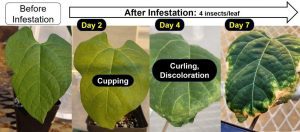
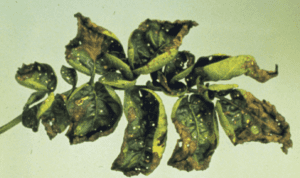
Monitoring is essential to detect the leafhoppers before extensive damage occurs and to evaluate if a damaging pest population is present. Check the
underside of leaves for nymphs and adults can be flushed out of foliage by shaking the plants. Insect sweep nets can be used to collect insects for counting. Action thresholds are available to make decisions about treatment needs. See the New England Vegetable Management Guide for crop-specific action thresholds and registered control products. Other management tactics include row covers for beans and eggplants and using varieties that are less susceptible to the leafhopper. For instance, potato varieties noted to be moderately resistant to leafhoppers include Katahdin, Elba and All Red while Russet Burbank is least susceptible to hopperburn.
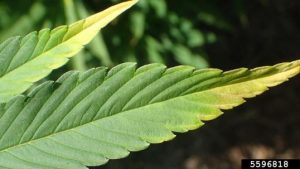
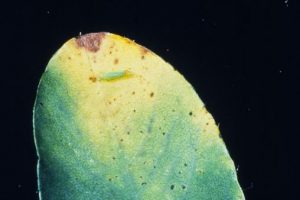
References
Backus, E. A., M. S. Serrano and C. M. Ranger. 2005. Mechanisms of hopperburn: an overview of insect taxonomy, behavior, and physiology. Ann. Rev. Entomol. 50: 125-51.
Calderwood, L., S. Lewins and H. Darby. 2015. Survey of Northeastern Hop Arthropod Pests and Their Natural Enemies, Journal of Integrated Pest Management 6 (1) https://doi.org/10.1093/jipm/pmv017
Chasen, E.M., C. Dietrich, E.A. Backus and E. M. Cullen. 2014. Potato leafhopper (Hemiptera: Cicadellidae) ecology and integrated pest management focused on alfalfa. J Integr Pest Manag. 5:1-8.
Lamp, W.O., G.R. Nielsen and S. D. Danielson. 1994. Patterns among host plants of potato leafhopper, Empoasca fabae (Homoptera: Cicadellidae). J Kans Entomol Soc.67: 354-368.
Seaman, A. 2016. Production Guide for Organic Potato. Publisher: New York State Integrated Pest Management Program, Cornell University, New York State Agricultural Experiment Station, Geneva, NY. http://hdl.handle.net/1813/42897